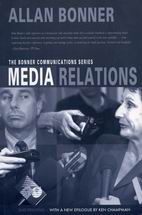
| Home News Releases | Calendar Contact |
Sources Bookshelf

Media Relations
The Bonner Communications Series
Bonner, Allan
Publisher: Sextant Publishing, Edmonton, CanadaYear Published: 2004
Pages: 173pp Price: $24.95 ISBN: 0-9731134-2-1
Library of Congress Number: HD59.B65 2004 Dewey: 659.2
Please see our media profile in Sources:
Allan Bonner Communications Management Inc.
Eight seconds.
It's the average length of time devoted to a spokesperson's remarks during a television news item. Are you prepared to make the best of it? Do you know where to begin?
Start by accepting the fact that the media moves faster than you do, so be prepared. Always.
This is the message of Allan Bonner's brilliant new book, Media Relations. In it he coaches the reader on attaining utmost media preparedness or, as he describes it, having SOCKOs.
SOCKO is an acronym for Strategic Overriding Communications and Knowledge Objective. It's a Bonner invention and fundamental to the media training he offers in this book, in his numerous published articles and at his Centre for Risk and Crisis Management in Toronto. SOCKO starts with strategic thinking and through "simplicity, brevity, clarity and repetition," can lead anyone to becoming media savvy.
By Bonner's definition, a SOCKO is "a short, positive, sharp, memorable, honed, polished, true, unassailable statement." According to Bonner it is always "20 seconds or less, quotable, full of impact and often showing caring, knowledge and/or action." Think of Pierre Elliot Trudeau's infamous "Just watch me," and you've got the idea.
In Media Relations, Bonner uses his SOCKO mentality to conquer the challenges of dealing effectively with the media. His writing is clean and concise. His lessons are no-nonsense and to the point. His key advice - "make your message powerful and clear and get it out early and often and you will always be ahead of your adversaries."
Every component of SOCKO is clearly articulated and its power demonstrated. Bonner reminds us that while reporters and editors are forced to make choices, we, as PR practitioners, can affect those choices. Central to Bonner's training model is the reality that "your message and demeanour can influence whether you are depicted as peripheral or central to the (news) story."
Once the SOCKO framework is introduced and explained, Bonner proceeds to describe (in greater and more relevant detail than I have previously encountered) the mechanics of media relations - how to organize and manage a media conference, how to structure and write a media release, the contents of a professional media kit, how to test your story idea for newsworthiness, and, most importantly, how to handle reporters face-to-face.
In under 200 pages (complete with illustrative photographs, a glossary, real-life examples and generous appendices of charts, worksheets and checklists) Allan Bonner packs an impressive one-two punch in media relations training - not just how, but why. There's method and motive to his message.
My recommendation is for you to buy this book and swiftly absorb the contents. Be confident that with Allan Bonner's expert instruction you can become more proficient and less intimidated when facing a media inquiry. His knowledge is your power. And power is having SOCKOs. Get ready. Aim. Fire.
[Review by Lynn Fenske]
Media Relations by Allan Bonner is available from Sources for $24.95. Visit http://sources-shop.com. Or, get a free copy when you order a Sources Membership at http://gateway.sources.com/Membership1.php
Subject Headings
© Sources 2023. The information provided is copyright and may not be reproduced in any form or by any means (whether electronic, mechanical or photographic), or stored in an electronic retrieval system, without written permission of the publisher.